Synthesis and characterization of robust, mesoporous electrodes for solid oxide fuel cells†
Abstract
The use of mesoporous electrodes in solid oxide cells would lead to a significant enhancement of the performance due to their high surface area and large number of active sites for electrochemical reactions. However, their application in real devices is still hindered by the potential instability of the mesostructure and morphology at high temperatures required for device fabrication and under severe conditions for high-current, long-term operation. Here we report our findings on the preparation and characterization of mesoporous electrodes based on ceria infiltrated with catalysts: an anode consisting of a Ce0.8Sm0.2O1.9 (SDC) scaffold infiltrated with Ni and a cathode consisting of an SDC scaffold infiltrated with Sm0.5Sr0.5CoO3−δ (SSC). In particular, a doped-zirconia electrolyte supported cell with a mesoporous Ni–SDC anode and a mesoporous SSC–SDC cathode demonstrates an excellent peak power density of 565 mW cm−2 at 750 °C (using humidified hydrogen as the fuel). More importantly, both mesoporous electrodes display remarkable stability, yielding a combined electrode virtual non-degradation for the last 500 hours of the test at a constant current density of 635 mA cm−2 at 750 °C, demonstrating the potential of these mesoporous materials as robust electrodes for solid oxide fuel cells or other high-temperature electrochemical energy storage and conversion devices.



 Please wait while we load your content...
Please wait while we load your content...